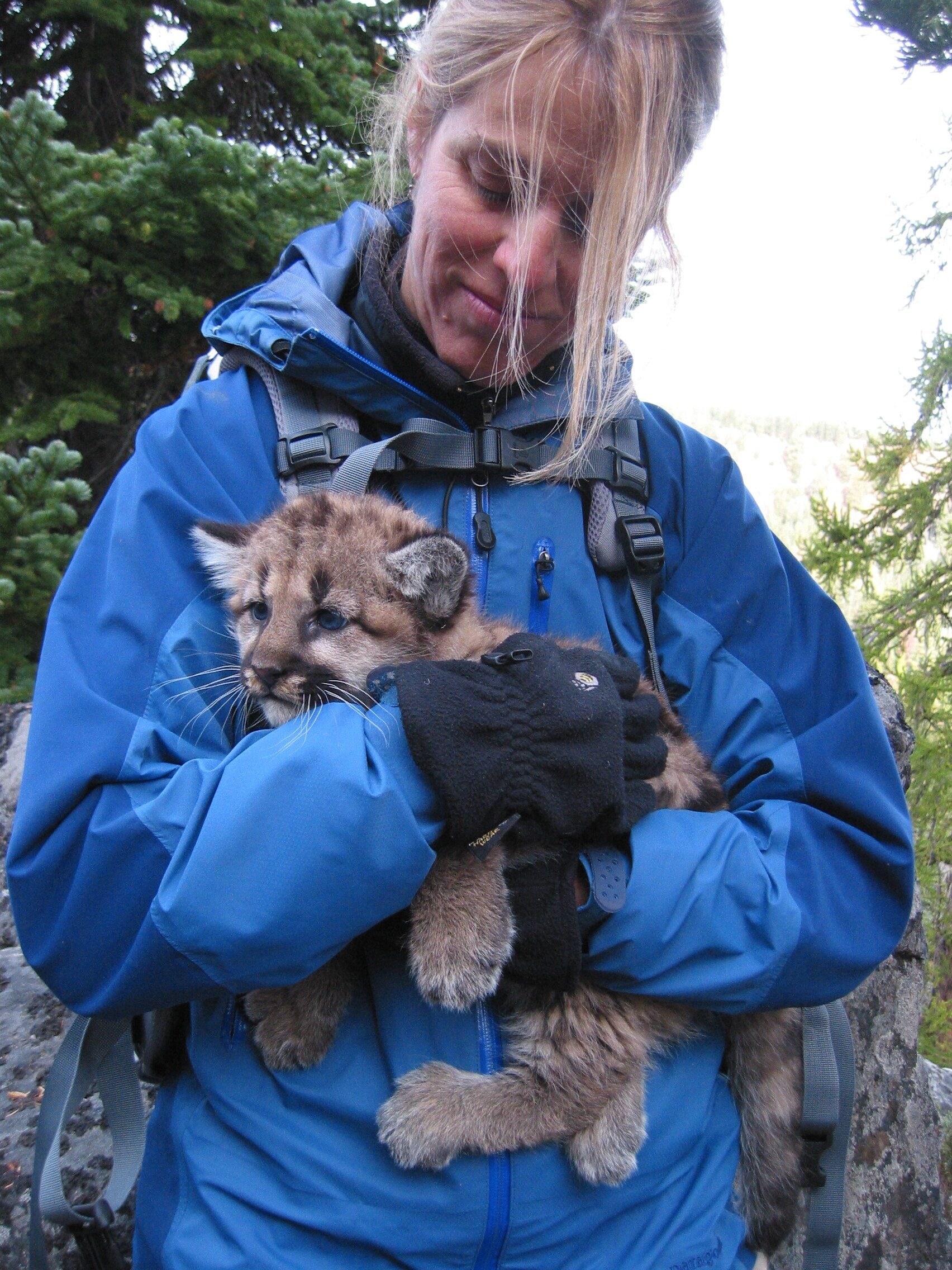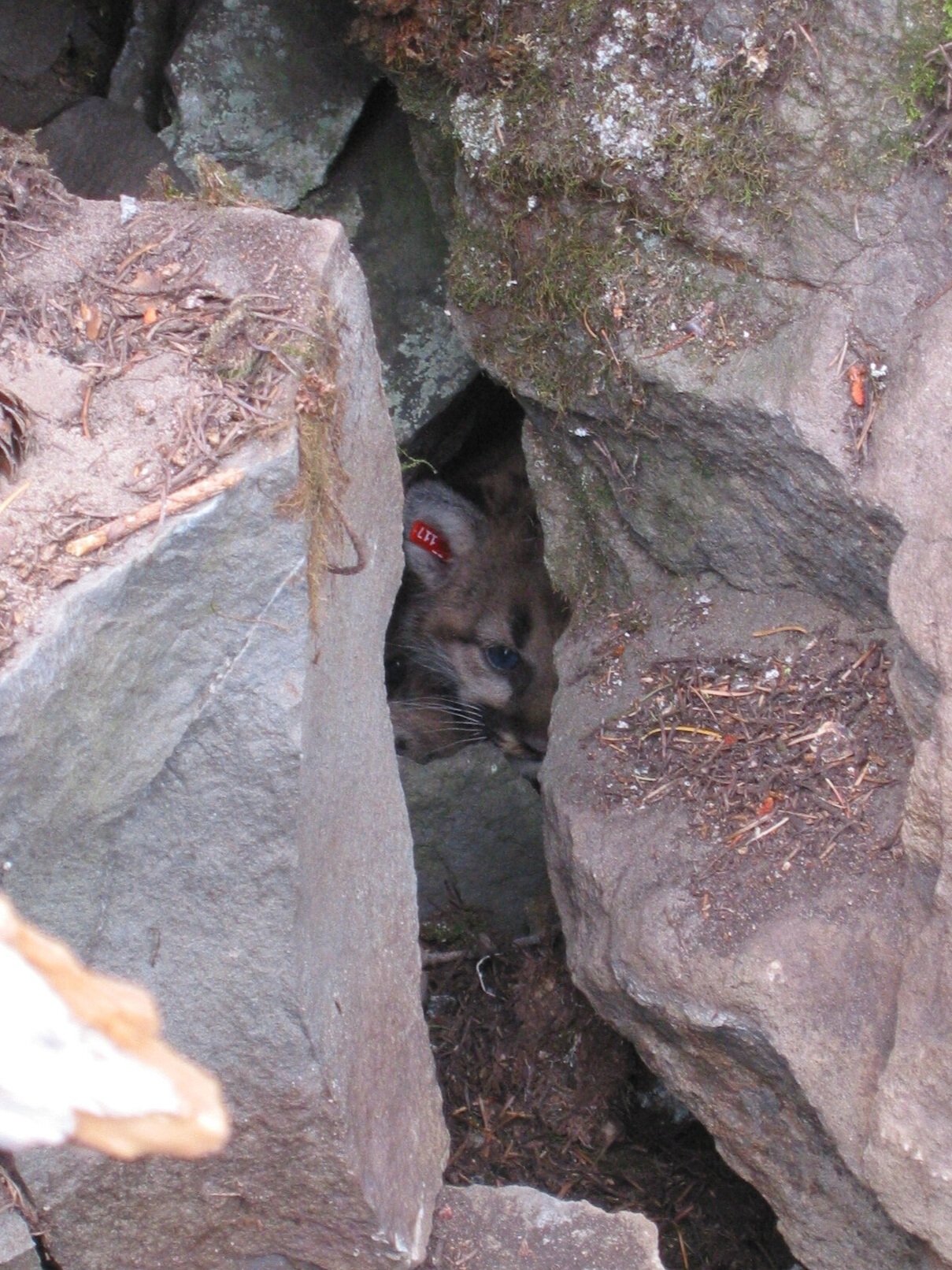Being with Cougars
A few weeks ago, I began to hear rumblings about a cougar on Bainbridge Island. Such rumblings are not uncommon, but this time there was supposedly photographic evidence. Sure enough, just after Christmas, a friend sent me a video clip of a large cat with a long tail approaching a wire fence and then leaping straight into it, apparently stalking a wary sheep on the other side. The video was taken by a wildlife camera not far from our house. The rumors were true: We had a new wild neighbor!
Despite the many miles I’ve hiked in the Cascades and the Olympics, I have yet to see a cougar, except for the kittens described in my story below. I know they’re out there; Robert and I often capture these keystone predators on our survey cameras hidden deep in the wilderness, and they’ve no doubt seen us romping by on a trail. But every summer, I hope to safely observe a free-roaming cougar—on a distant slope, perhaps, or crossing a quiet Forest Service road. Maybe this will be the year!
Of course, not everyone is as excited as I am about the possibility of seeing a cougar, especially in a densely populated place like Bainbridge. Although there are deer and other natural prey available for cougars here, the island is a tough place to not run into people or domestic animals. The island cougar hasn’t shown any interest in humans, but he (or she) has reportedly killed a few goats and sheep.
No doubt these losses have been a tragic experience for the people (and livestock) involved. But I certainly don’t cast judgment on the cougar, any more than I would a robin foraging for worms or a hungry shopper at the market. Movement through the landscape is as natural for cougars at it is for the birds we watch at our feeders—and we all need to eat to survive.
I do worry about the fate of this cougar, however, and I hope s/he can avoid further trouble while s/he’s here on the island. I also hope my fellow islanders can show our visiting cougar the tolerance and compassion that makes Bainbridge such a special place to live, and can follow expert tips for coexisting with cougars as needed.
The cougar’s presence has made me think back to “babysitting” a wild cougar kitten when Robert and I first moved to Washington in 2007. Soon after, I wrote about this unforgettable encounter for the HSUS Wildlife Land Trust, and I’ve posted a slightly edited version of my newsletter article below.
About 5 years ago, I also had the opportunity to help edit the script for a short science film about cougars, sometimes called mountain lions. The Secret Life of Mountain Lions was produced by my friend Sharon Negri and received wide and well-deserved praise. You can watch the film by clicking the video arrow below.
Humane Conservation
Edited from Wildlife Lands, The Newsletter of The Humane Society of the United States Wildlife Land Trust, Annual Report Issue, Summer 2008.
Last fall, my husband, Robert, and I were invited to join fellow wildlife researchers in capturing a pair of cougar kittens in Washington’s eastern Cascades. The kittens, only six weeks old, were to become part of a regional effort to better understand how cougars respond to encroaching development.
After they were fitted with high-tech collars, the kittens’ daily movements (and those of their mother) would be precisely tracked through an increasingly suburbanized landscape. The capture was successful, and I spent one of the most poignant hours of my professional life babysitting the first kitten while the remaining crew searched rocky crevices for her sibling.
As those nine pounds of wildness lay trembling in my arms, I was overwhelmed with both the magic of the moment and the underlying injustice that brought our lives together on that steep talus slope. When people and wildlife compete for limited space, the latter are too often the losers.
The following morning, Robert and I ventured back to the same area to explore its mysteries on our own. Hiking up the dirt road, we encountered an elder outdoorsman hanging out at his tailgate, nursing a mug of hot coffee in the brisk autumn sunshine. He was ostensibly scouting for elk, although he confessed that fresh air and mountain solitude were his ultimate quarries.
Concerned for the safety of our golden Lab, Cedar—a dead ringer for a deer when he’s bounding through the forest—I queried the gentleman about the timing of hunting season. He reassured me that elk season wouldn’t begin for a while yet, but added as an afterthought that this was opening day for cougars.
My head swam with panic as my eyes desperately scanned the hillside above. Irrationally, I feared that one of our tiny tracking collars might catch a gleam of light and betray the location of a family whose survival hung in the balance. More realistically, the thought that the two innocent kittens could be left motherless with a single shot was almost too much to bear.
Regardless of where we live, most of us don’t need to look far beyond our backyards to see habitat being lost to housing, roads, and other development. As the land around us gets broken up into ever smaller bits of habitat, wildlife populations have fewer and fewer resources to meet their needs.
Cougars and other animals who must travel long distances for food and mates are often unable to move effectively between habitat islands, thus being restricted to isolated populations. Wild predators prone to persecution are even more vulnerable to the effects of a fragmented landscape, as their safety is compromised when they’re forced into close proximity with people. Add global warming to the mix and we have a rapidly growing biodiversity crisis on our hands—and on our consciences.
Today more than ever wild animals need sanctuary, places where they can find refuge from the dangers and disturbances of humanity. In a perfect world, wildlife sanctuaries would be large enough to sustain existing and future generations of the widest-ranging species, but even our majestic national parks aren’t sufficient to safeguard individuals who move beyond park boundaries.
True protection will require more big wild spaces, more corridors of healthy habitat linking populations together, and more people who are willing to do their part to create a wildlife-friendly world.
With the vast majority of land held in private ownership, landowners who love wildlife have a critical role to play in bringing this vision to fruition. Each of us holds the key to a home not only for ourselves, but for the myriad species whose future depends on our ability to make room for them.
I’m happy to report that our young cougar friends weathered their first long winter with their mother by their side. Unfortunately, their grandmother—who occupied an adjoining territory—wasn’t so lucky, her life curtailed by a hunter’s gun.
Her fate could have just as easily been sealed by a collision with a car in a failed attempt to cross the nearby highway, or in a lethal conflict with people if her ramblings had led her to a neighboring ranch—equally unsuitable endings for a being of such beauty and ecological importance.
Cougars, like all of us, deserve to life self-willed lives. We need to secure more habitat now, because it’s the humane thing to do.



